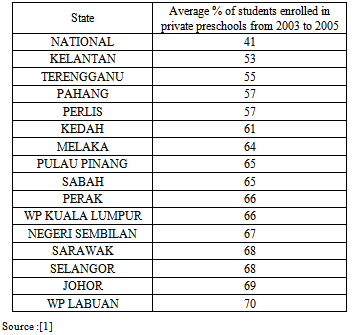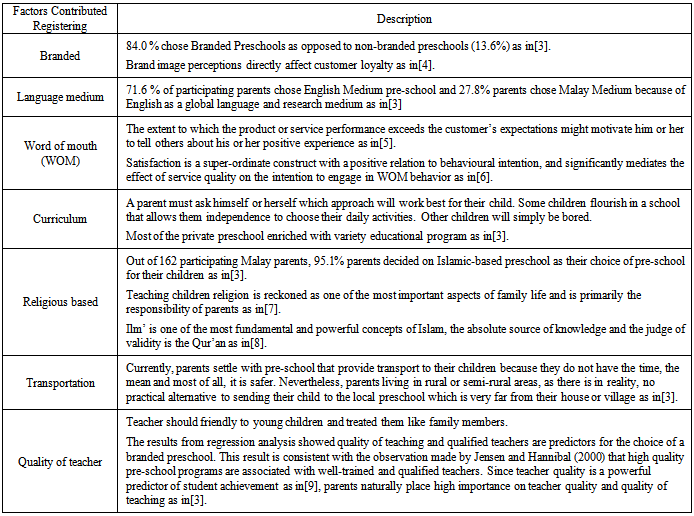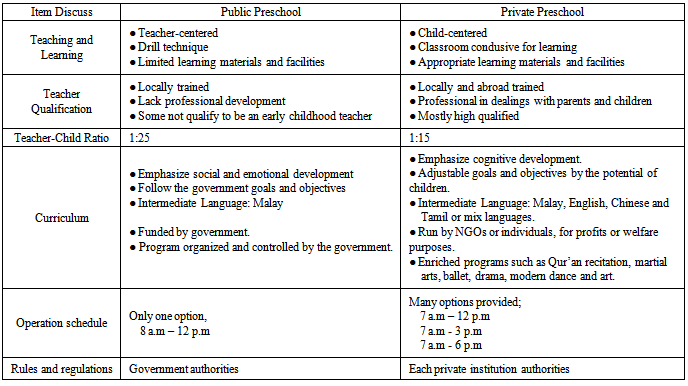Lily Muliana Mustafa1, Mohamed Nor Azhari Azman2
1Faculty of Management and Economy, Universiti Pendidikan Sultan Idris
2Faculty of Technical and Vocational Education, Universiti Pendidikan Sultan Idris
Correspondence to: Lily Muliana Mustafa, Faculty of Management and Economy, Universiti Pendidikan Sultan Idris.
| Email: |  |
Copyright © 2012 Scientific & Academic Publishing. All Rights Reserved.
Abstract
The aim of this study is to identify the history background of private and public preschools, the emerging trends and implications for the future. The establishment of preschool is to provide early child education program for children age 4 to 6 years old. The Malaysian government had listed the standard operating procedure for the preschool operators to comply with the regulations accordingly. Although government provide free charges or less fees compare with private preschool, the trends parents registering their children to the private preschool are emerging. To arrive at these findings and the discussions in this paper, reference was made to papers presented at various sources of journals and by documented policies from Curriculum Development Centre, Ministry of Education Malaysia. The concepts of private and public preschools are viewed by many scholars as the same, in that the main objective of the establishment is an institution providing education services for the early stage of children. Hence, this research intends to conduct a study on the preschool in Malaysia, the emerging trends and the implication for the future. Trends of parents to register their children in the private preschool may identify the factors contributed towards the emerging of private preschool as an alternative or a requirement in our daily life. The implications for the future while investing in early childhood education will benefit individual children and society as a whole.
Keywords:
Preschool, Private, Public, Parents’ trends
Cite this paper: Lily Muliana Mustafa, Mohamed Nor Azhari Azman, Preschool Education in Malaysia: Emerging Trends and Implications for the Future, American Journal of Economics, Vol. 3 No. 6, 2013, pp. 347-351. doi: 10.5923/j.economics.20130306.15.
1. Introduction
Malaysia has three Ministries involved in the early childhood education, i.e. Ministry of Education (MOE), Ministry of Rural and Regional Development, as well as Department of National Unity and Integration under the Prime Minister Department. Early childhood education is focusing for the 4-6 years old group. Kemajuan Masyarakat (KEMAS) falls under the responsibilities of Ministry of Rural Development is the pioneer in setting up preschools in Malaysia (beginning early 1970’s). Currently there are 8307 preschools set up by this Ministry which are commonly known as the KEMAS preschool as in[1].In the late 1970’s Department of National Unity and Integration set up preschools in the urban areas where there are ‘Rukun Tetangga’, a friendly neighborhood scheme. These preschools are generally known as the PERPADUAN preschools. PERPADUAN preschools must accept students from the different races, currently, there are 1496 PERPADUAN preschools. In the year 1992, preschool was set up by MOE in the form of pilot project as an annex to the existing primary school called as prasekolah. MOE preschool project was rolled out to whole nation in the year 2003. Currently, there are 5905 of these preschools which are situated all over the country. Other than MOE, KEMAS and PERPADUAN preschools, other providers of preschool education include also the State Religious Department, Jabatan Agama Islam Negeri (JAIN) and the Angkatan Belia Islam Malaysia (ABIM).An overview of the composition of preschools according to the providing public agencies as of 2007 is given in Table 1. Table 1. Three Main Types of Public Preschools in Malaysia 2007
 |
| |
|
2. Public Preschool
The existing of public preschools in Malaysia giving chances for parents to register their children at the early age. Children learn three basic knowledge such as reading, counting, and writing in a formal education provided here by the government. The three public preschools are KEMAS, PERPADUAN and MOE preschool shown in Table 2 with the major characteristics such as objective of establishment, number of students and the location of institutions. However, the public preschools are related in terms of curriculum implemented and the regulations of daily operations.Table 2. Major Characteristics of Public Preschools in Malaysia
 |
| |
|
3. Private Preschools Run by Private Sectors and Non-Government Organizations
Preschools set up by the private sector have always been seen by the government as an alternative to give quality education to children especially by affordable parents. Children going to these preschool education age from 4-6 years. These preschools are required to use the National Preschool Curriculum as stipulated in the National Education Act 1996. Medium of instruction can be the National Language, Chinese, Tamil or English. The curriculum emphasize on communication skills, social skills and other skills to prepare them to the primary (formal) education. Private preschools can offer additional program upon approval from MOE. Fees charged varies from as high as RM 1000 or more per month to as low as RM 10 or RM 20 per month.
3.1. Enrolment in Private Preschools
Table 3 provides information on enrolment of students in the private preschools. In the year 2005, 43% of the children who participate in preschools are from these privately run preschools. There is a decline in enrolment of students in the private preschools in the past few years. The sharpest decline occurred in 2003 which coincided with the year MOE began setting up its preschools in a big scale. This shows that preschool offered by MOE could attract a sizable population, perhaps since it is non-paying and since it is part of the formal school system. Children from MOE preschools could continue with Primary Education in the same school.Table 3. Percentage of Students Enrolled in Private Preschool
 |
| |
|
Table 4 provides the average percentage of students enrolled in private schools from the year 2003 to 2005. The states where private preschools are more prevalent are Labuan (70%), Johor (69%), Selangor (68%), Sarawak (68%), Negeri Sembilan (67%), Kuala Lumpur (66%), and Perak (66. States recorded lower private preschools enrolment are Kelantan (53%), Terengganu (55%), two east coast states. Government preschools from whichever agencies or ministries receive regular funding and assistance from the central government in terms of infrastructure, teacher training, teachers’ salary and equipment.Table 4. Average % of Students Enrolled In Private Preschools from 2003 to 2005
 |
| |
|
4. Factors Contributed the Parents’ Trends
Parents generally are worried about their children’s’ readiness to enter Year 1. The parents’ trends are to ensure the private preschool may fulfill their expectation regarding their children performance in academic and discipline. They want their children to be drilled with the reading, writing and mathematical skills and they want to see the outcome in the form of test marks. They also consider other hands-on activities as mere play and not serious work and non-productive. The parents pressured the kindergarten to teach primary school syllabus as some of their children are required to sit for primary school entrance examination for acceptance or streaming purposes as in[2]. Such schools are usually the private schools, religious schools or some of the elite public schools including Chinese primary schools. Public primary schools in general are not encouraged to do this.Table 5 explains factors contributed parents’ trends towards private preschool in Malaysia. Those factors are branded, language medium, word of mouth, curriculum, religious based, fees, location, transportation, quality of services, quality of education management, quality of teacher, safety and security, hygiene, nutritious food, and infrastructure.Table 5. Factors Contributed Parents’ Trends Towards Private Preschool
 |
| |
|
5. Differences between Public and Private Preschool in Malaysia
The public and private centers are very different in their goals and how they run their program and centers in many aspects such as on teaching and learning, teacher qualifications, teacher--‐child ratio, curriculum, operation schedule. Table 6 illustrates these differences.Thus, from the differences of both preschools give parents chances which preschools fulfil their objectives educating their young children. Concept of teaching and learning, teacher qualifications, teacher-child ratio and curriculum implementations depend towards the goals and regulations stated by each private preschool. Every private preschool have their own speciality while promoting their preschool to the customers such as inclusive free additional art class. When parents considered more about extended operating hours the preschool provided, thus choosing private preschool will be the right decision. Reference[10] shows factors that encourage extended operating hours and seven-day operations such as:a) Economic pressure from consumers. The growing number of two-income families and single wage earners who live alone need time outside normal working hours to shop and use other services. When parents working or attending courses on weekends, they need to send their children to the preschool which provided tuition and day care services. Thus, parents will not worry who will take care their young children from morning until evening.b) Economic incentives to improve asset utilization. A great deal of capital is often tied up in service facilities. The incremental cost of extending hours tends to be relatively modest, and if it reduces crowding and increases revenues, then it is economically attractive. c) Availability of employees to work during “unsocial” hours. Changing lifestyle and a desire for part-time employment have created a growing labor pool of people willing to work evenings and nights. They include students looking for part-time work outside classroom hours, people working a second job, parents juggling child-care responsibilities, and others who simply prefer to work by night and relax or sleep by day.d) Automated self-services facilities. Self-service equipment has become increasingly reliable and user friendly. Many machines now accept card-based payments in addition to coins and banknotes. Installing unattended machines may be economically feasible alternative for locations that cannot support a staffed facility. Although each public and private preschool have their own goals and regulations, making quality education more accessible will ensure more Malaysians gain the chance to improve their standard of living. In addition, resources would be used effectively to deliver improved outcomes and divided equitably between schools of different educational standards to benefit all students irrespective of their starting point. This equitable division would allow all students to gain the basic skills required to be a productive member of society while also providing the opportunity for exceptional students to realise their full potential as in[11].
5.1. Implication for the Future
The concept of National Key Result Areas (NKRA), and Key Performance Indicators (KPI) in 2009, the role of education to ‘produce trained manpower’ seems to have taken precedence over the other desirable goal of the education system – to develop the child fully, inculcate and develop desirable moral values, transmit knowledge and create a united Malaysian with multi-ethnic races. The aspiration of the Education NKRA is to improve student outcomes across Malaysia’s school system and to enable access to quality education for all students. Improving student outcomes is crucial to developing a more competitive workforce as Malaysia pushes towards becoming a developed nation by 2020 as in[12].With regard to private for-profit organizations, generally they are perceived to be more efficient and effective in the provision of services and less bureaucratic. This enables them to manage their services effectively and efficiently and to act quickly to adapt to changing conditions. For the most part, this characteristic of the private sector is linked to its goal to make a profit. It needs to ensure efficiency in resource allocation and in management and to be customer-oriented to achieve its goal as in[13]. To survive in the competitive market, the private sector has to keep its costs low and maintain its reputation high. Table 6. Public vs Private Preschool in Malaysia
 |
| |
|
Potential problems could arise when the private sector is driven by profit motive. There is a tendency for the for-profit organizations to sometimes sacrifice quality to maximize profit. For example, unlike the public sector, for-profit organizations could discontinue services when facing financial problems. They are also not overly concerned with issues such as equal access. Instead, they tend to avoid services to those whose payment capacity is limited. Moreover, there might be conflicts between the for-profit principle and the value of education.
6. Conclusions
Although competition among preschools is one way to promote their institutions, government action should be taken to make preschool education more accessible for children from all backgrounds, whether it is ethnic, economic, or social. The impact towards continuous monitoring the emerging of preschools will help to provide the best quality services in each public or private preschool in Malaysia. Quality servicers will gain quality education for each child in the preschool institutions. Instead, the Malaysian government has made education one of the priority areas to bring about “broader reforms to the National Education System over time” (Tan Sri Dato’ Haji Muhyiddin bin Mohd Yassin, Minister of Education, quoted as in[11]. An overwhelming majority of parents prefer to send their children to the private preschool compare to the public preschool. Private preschools provide us with an alternative to educate our children in order to achieve basic knowledge before further studying in primary school. For Muslims’ parents concern, the private preschool also provide more religious environment to the children as what parents aim to ensure their children can read Qur’an and pray at the early age. The first five years of a child’s life has long been acknowledged by psychologists as important for their formative years as in[14]. Therefore, it is of utmost importance for the parents to seek for quality preschools institutions to ensure the proper upbringing of their children in their early years.
References
| [1] | CDC (2007). Curriculum Development Centre, Ministry of Education Malaysia (Early Childhood Care and Education Policy Implementation Review 2007). |
| [2] | MAPECE (2007). Malaysia Association of Profesional Early Childhood Educators,http://www.tadika.org/Malaysian_ECCE_Policy_Review_24_Jan_2008.pdf |
| [3] | Dahari, Z and Ya, M.S. (2011). Factors that Influence Parents’ Choice of Pre-Schools Education in Malaysia: An Exploratory Study. International Journal of Business and Social Science, 2(15), 115-128. |
| [4] | Allen, D.R. and Rao, T. R.N. (2000). Analysis of Customer Satisfaction Data: A Conprehensive to Guide to Multivariate Statistical Analysis in Customer Satisfaction, Loyalty and Service Quality Research. Asq Press. |
| [5] | Celso, A.D.M and Carlos, A.V.R. (2008). Word-of-Mouth Communications in Marketing: A Meta-Analytic Review of the Antecedents and Moderators. Academy of Marketing Science, 36 (4), 578-596. |
| [6] | Lee J., Lee J., & Feick L. (2006). Incorporating word-of- mouth effects in estimating customer lifetime value Journal of Database Marketing & Customer Strategy Management; 14 (1), 29-39. |
| [7] | Waddy, C. (1982). The Muslim Mind. London: Longman Group Limited. |
| [8] | Ziauddin Sardar (1988). The Future of Muslim Civilization. Petaling Jaya: Pelanduk Publications. |
| [9] | Jensen, M. A. & Hannibal, M. A. 2000, 'Advocacy and leadership: New professional challenges', in Issues, Advocacy and Leadership in Early Childhood Education, 2nd edn, eds M. Jensen & M. Hannibal, Pearson Education, Needham Heights MA, 3-5. |
| [10] | Christopher, L and Jochen, W. (2011). Services Marketing People, Technology, Strategy. Prentice Hall, New Jersey. |
| [11] | PEMANDU, Performance Management Delivery Unit (2010). Government Transformation Roadmap: NKRA Education, Chapter 8 Improving student outcomes.http://www.pemandu.gov.my/index.php. (Accessed on 30 July 2010). |
| [12] | Wang. Y (1999) Asian Development Bank Institute Public- Private Partnerships in Health and Education: Conceptual Issues and Options. |
| [13] | Bennett, S. (1991). The Mystique of Markets: Public and Private Health Care in Developing Countries. PHP Departmental Publication No. 4. London School of Hygiene & Tropical Medicine. |
| [14] | Chiam, H.K. (2008). Child Care in Malaysia: Then and Now. International Journal of Child and Education Policy, 2(2), 31-41. |

 Abstract
Abstract Reference
Reference Full-Text PDF
Full-Text PDF Full-text HTML
Full-text HTML




